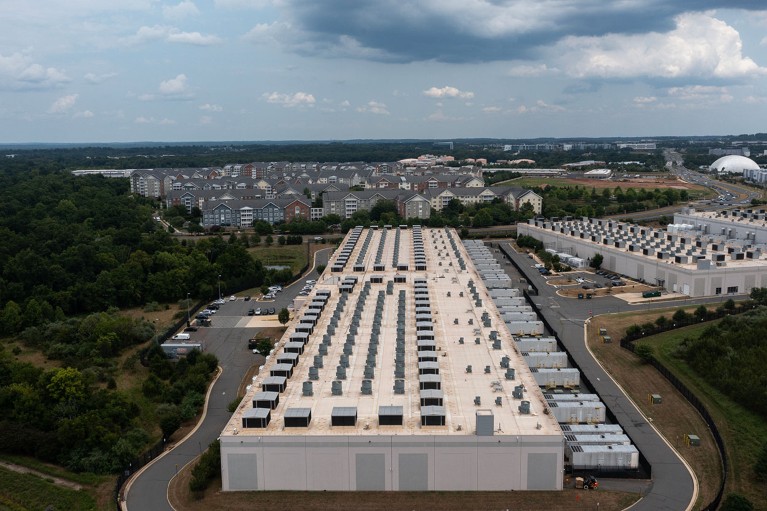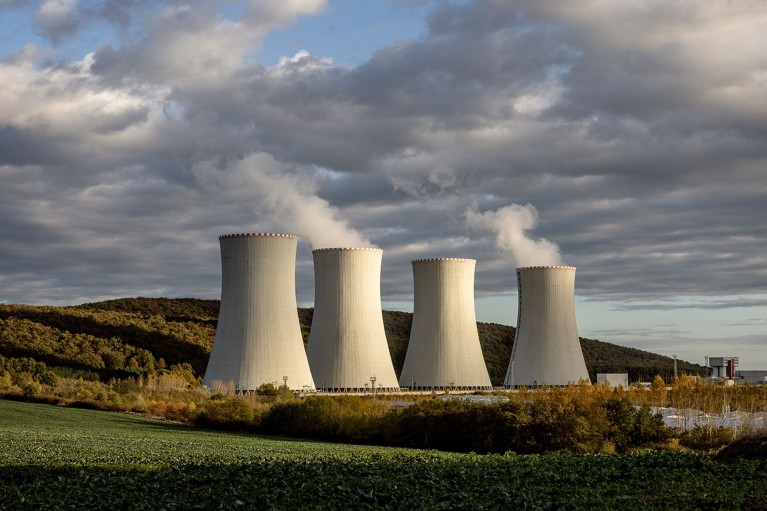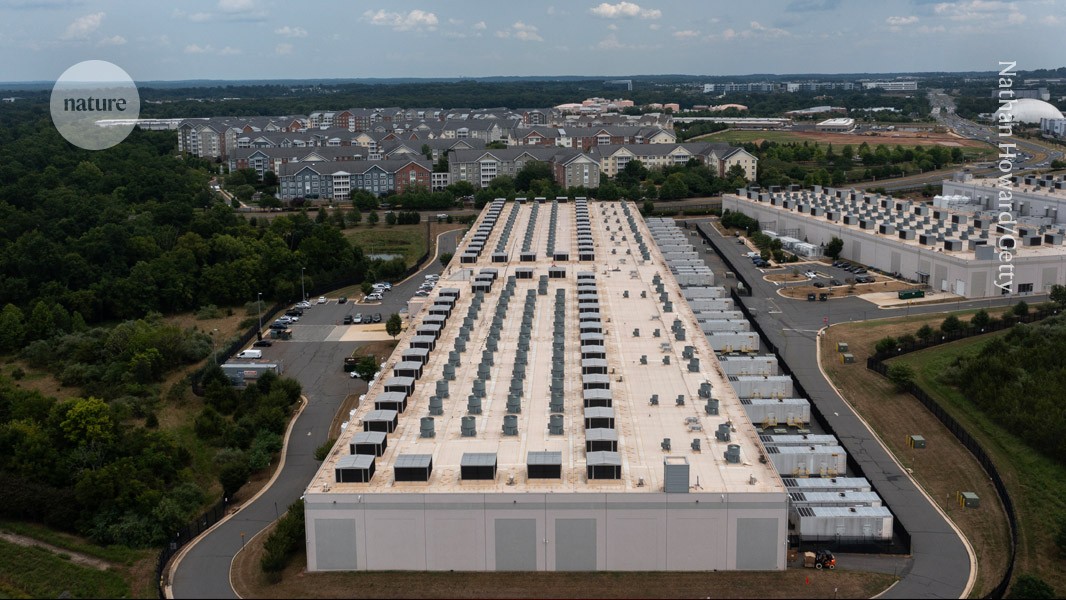
An Amazon data centre in Ashburn, Virginia. Technology companies are investing in nuclear power to try and address the growing energy demands of such facilities.Credit: Nathan Howard/Getty
Last week, technology giants Google and Amazon both unveiled deals supporting ‘advanced’ nuclear energy, as part of their efforts to become carbon-neutral.
Google announced that it will buy electricity made with reactors developed by Kairos Power, based in Alameda, California. Meanwhile, Amazon is investing approximately US$500 million in the X-Energy Reactor Company, based in Rockville, Maryland, and has agreed to buy power produced by X-energy-designed reactors due to be built in Washington State.
Nuclear power for AI: what it will take to reopen Three Mile Island safely
Both moves are part of a larger green trend that has arisen as tech companies deal with the escalating energy requirements of the data centres and number-crunching farms that support artificial intelligence (AI). Last month, Microsoft said it would buy power from a utility company that is planning to restart a decommissioned 835-megawatt reactor in Pennsylvania.
The partnerships agreed by Google and Amazon involve start-up companies that are pioneering the design of ‘small modular reactors’, which are intended to be assembled from prefabricated pieces. The idea is to make nuclear reactors that are smaller, cheaper, safer and faster to deploy than those used in conventional plants. The designs pursued by X-energy, Kairos and several other companies (funded, in part, by institutions such as the US Department of Energy and the European Commission) are radically different from those of established energy companies, but they still have a way to go before they become a reality.
Nature talked to nuclear-energy researchers to explore the significance and possible implications of these big-tech investments.
Could these deals spur innovation in the nuclear industry?
Building nuclear power stations — a process often plagued by complex permit procedures, construction delays and cost overruns — is financially risky, and betting on unproven technologies is riskier still. But the deals with Google and Amazon could provide a “massive” push for Kairos and X-energy, says nuclear engineer Jacopo Buongiorno, who heads up the Center for Advanced Nuclear Energy Systems at the Massachusetts Institute of Technology in Cambridge. “The biggest value is a vote of confidence, and of course it comes with some cash,” he says. Such announcements could help companies to raise extra funding, he says, and jump over the ‘innovation valley of death’ that often separates promising ideas from commercial success.
But the details of the deals are murky, and the level of support provided by Amazon and Google is likely to be “a drop in the bucket” compared with the billions these start-ups will ultimately need, says physicist Edwin Lyman, director of nuclear power safety at the Union of Concerned Scientists in Washington DC. “The PR machine is just going into overdrive,” says Lyman, but “private capital just doesn’t seem ready yet to take that risk”.
Allison Macfarlane, director of the School of Public Policy and Global Affairs at the University of British Columbia in Vancouver, Canada, and former chair of the US Nuclear Regulatory Commission (NRC), says that the speed of progress in computer science raises another question. “If we’re talking 15 years from now, will AI need that much power?”
How do small modular reactors work?
A number of start-up companies — as well as some established corporations, including Toshiba and Rolls Royce — are developing small reactors, and each claims its own originality and advantages. Most are pursuing designs that are different from those that have been used so far for electricity production.
Nuclear energy, ten years after Fukushima
In almost all types of nuclear reactor, the source of energy is the splitting of uranium atoms. A nucleus of the unstable isotope uranium-235 breaks up when hit by a neutron, and this releases more neutrons, which hit more nuclei, leading to a chain reaction. A conventional nuclear power station extracts the resulting energy — released as heat — by pumping cold water through the reactor’s core and producing pressurized steam to power turbines that generate electricity.
X-energy’s design replaces the water with helium, whereas Kairos plans to use molten salt. Both forgo the conventional nuclear-fuel rods, replacing them with thousands of round fuel ‘pebbles’. The pebbles are continually added at the top of the reactor, while spent pebbles are removed from the bottom, not unlike the way a gumball vending machine works.
Are there safety advantages to the small modular designs?
“The smallest reactors, in theory, could have a high degree of passive safety,” says Lyman. When shut down, the core of a small reactor would contain less residual heat and radioactivity than does a core of the type that melted down in the Fukushima Daiichi disaster that followed the cataclysmic 2011 tsunami in Japan.
The companies also say that the proposed pebble-bed reactors are inherently safer because they are not pressurized, and because they are designed to circulate cooling fluids without the help of pumps (it was the loss of power to water pumps that caused three of the Fukushima plant’s reactors to fail).
But Lyman thinks it is risky to rely on potentially unpredictable passive cooling without the backup of an active cooling option. And as reactors become get smaller, they become less efficient. Another start-up company, NuScale Power, based in Portland, Oregon, originally designed its small modular reactor — which was certified by the NRC — to produce 50 MW of electricity, but later switched to a larger, 77-MW design. The need to make the economics work “makes passive safety less credible”, Lyman says.
Do small modular reactors carry extra risks?
In some cases, small modular reactors “could actually push nuclear power in a more dangerous direction”, says Lyman. “Advanced isn’t always better.”
In particular, Lyman points out that the pebble-bed designs drawn up by X-energy and Kairos would rely on high-assay low-enriched uranium (HALEU), which comprises 10–20% uranium-235 — compared with the 5% enrichment level required by most existing reactors (and by NuScale’s reactor). HALEU is still classified as low-enrichment fuel (as opposed to the highly enriched uranium used to make nuclear bombs), but that distinction is misleading, Lyman says. In June, he and his collaborators — including physicist Richard Garwin, who led the design of the first hydrogen bomb — warned in a Science article that a bomb could be built with a few hundred kilograms of HALEU, with no need for further enrichment1.

Small modular reactors are designed to be cheaper, safer and faster to build than those used in conventional nuclear power plants, such as this one in Mochovce, Slovakia.Credit: Janos Kummer/Getty
Smaller reactors are also likely to produce more nuclear waste and to use fuel less efficiently, according to work reported in 2022 by Macfarlane and her collaborators2. In a full-size reactor, most of the neutrons produced by the splitting of uranium travel through a large volume of fuel, meaning that they have a high probability of hitting another nucleus, rather than colliding with the walls of the reactor vessel or escaping into the surrounding building. “When you shrink the reactor, there’s less material in there, so you will have more neutron leakage,” Macfarlane says. These rogue neutrons can be absorbed by other atomic nuclei — which would then themselves become radioactive.
NuScale points out that the study was based, in part, on the company’s now-abandoned 50-MW design, but Macfarlane and others say that the problem is likely to apply to most small reactors.
Will small reactors be cheaper to build?
The capacity to build components in an assembly line could drastically cut reactors’ construction costs. But there are also intrinsic economies of scale in building larger reactors, says Buongiorno. “Don’t believe people blindly” when they say smaller reactors will produce cheaper energy, he says: nuclear energy has a lot going for it, but “it ain’t cheap” — and that is unlikely to change significantly.
However, once the technology has been proven and has matured, building each individual small reactor should be cheaper and faster than constructing large, conventional ones, Buongiorno adds. This could make them an attractive proposition to investors and speed up their adoption.
Meanwhile, Lyman and others worry that the hype surrounding small modular reactor technology — and the push to cut costs — could lower safety standards. Some companies, for example, say that their reactors are so safe that they won’t need reinforced-concrete containment structures.
Will all of these efforts help to combat climate change?
“We shouldn’t shut down existing nuclear power. We need it desperately, and we desperately need to get off fossil fuels,” says Macfarlane. Even some lifelong opponents of nuclear power grudgingly agree.
But whether building new reactors is the best way to rapidly cut emissions is debated. Macfarlane points out that solar panels and wind turbines can be deployed at a much faster rate. Other assessments, including one by the International Energy Agency, suggest that in many parts of the world, it would be prohibitively expensive to rely wholly on erratic solar and wind power, even with the addition of massive batteries — and that ready-on-demand sources, including nuclear power, will still have an important role in future energy provision3.




